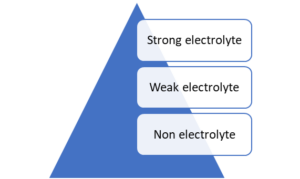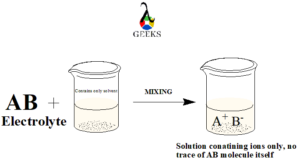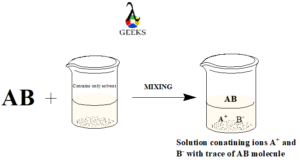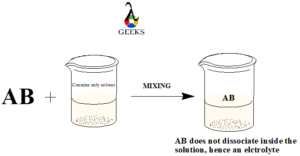Strong electrolytes are a good conductor of electricity and have wide applications in the real world. Strong acids and strong bases usually come under this category as they completely dissociate into ions in their molten stage.
- Hydriodic acid (HI)
- Hydrobromic acid (HBr)
- Hydrochloric acid (HCl)
- Sulphuric acid (H2SO4)
- Nitric acid (HNO3)
- Triflic acid (CF3SO3)
- Fluorosulfuric acid ( FSO3H)
Hydriodic acid (HI)
Also knowns as hydriodic acid and exist as an aqueous solution of HI (hydrogen iodide). It comes under the category of strong acid.
In addition, it dissociates completely on mixing in solution and therefore it is a strong electrolyte. It is colourless and usually exists around 47-58% in solution.
Uses:
It is used as the reducing agent in some chemical reactions.
Hydrobromic acid (HBr)
Hydrobromic acid is known as one of the strongest mineral acids after hydriodic acid. The Pka value is around -9 which makes it a strong acid as well as a strong electrolyte.
It dissociates inside the aqueous solution to give positive hydrogen ions and negative bromide ions with no trace of the molecule itself.
Uses:
It is famous for using as a source of H+ in anti- Markovnikov reactions of alkenes hydrogenation.
It is used for making organobromine compounds
Hydrochloric acid (HCl)
Hydrochloric acid is quite famous in the world of chemistry itself and is also called muriatic acid. Inside the solution, it exists as [H+(aq) Cl−(aq) or H3O+ Cl−] with a very strong pungent smell. It comes under the category of strong electrolyte with a large Ka value.
There is quite an interesting thing about HCl is, that it is present inside the digestive tract of the human body ( stomach) and plays a vital role in process of digestion.
Uses:
The important application of HCl is in the refining of metals
Also, used as a source of acid in numerous organic reactions.
Sulphuric acid (H2SO4)
It is a colourless acid known as the king of acids and also called the oil of vitriol. H2SO4 is polar with a dielectric constant value of 100 due to which it has high electrical conductivity.
When H2SO4 is mixed with solvent it undergoes autoprotolysis ie. It dissociates by pronating itself as shown above.
2 H2SO4 ⇌ H3SO+4 + HSO−4
Uses:
It is used as a dehydrating agent.
It is used in a wide number of industrial processes such as contact process, wet sulfuric method and also in lead chamber process.
Use as an electrolyte in lead-acid batteries involves the following reactions
At anode
Pb + SO2−4 ⇌ PbSO4 + 2 e−
At cathode
PbO2 + 4 H+ + SO2−4 + 2 e− ⇌ PbSO4 + 2 H2O
Overall:
Pb + PbO2 + 4 H+ + 2 SO2−4 ⇌ 2 PbSO4 + 2 H2O
Nitric acid (HNO3)
Nitric acid is used for nitration and is also a very strong oxidising agent. The terms like aqua fortis and spirit of niter are also used for it.
At ambient temperatures, nitic acid is considered a strong acid and when dissolve with solvent it readily undergoes self-autoionsiation is called autoprotolysis
2 HNO3 ⇌ NO+2 + NO−3 + H2O
Uses:
Used for carrying out the xanthoproteic test of proteins
In the agricultural field, used for the preparation of fertilizers.
Used for metal refining, cleaning agent and also in nuclear fuel reprocessing
Used in aqua-regia also
Triflic acid (CF3SO3)
Troiflic acid is a sulfonic acid with the value of Ka= 5×1014, pKa −14.7±2.0 which makes it a superacid and dissociates inside the solution completely to conduct proton conduction.
Uses:
Triflic acid is used in Friedel craft reactions as a strong acylating agent as shown above:
CH3C(O)Cl + CF3SO3H → CH3C(O)OSO2CF3 + HCl
CH3C(O)OSO2CF3 + C6H6 → CH3C(O)C6H5 + CF3SO3H
It also increases the octane rating for petroleum-based fuels
Used as a source of acid in many organic synthesis reactions such as alkylation, esterification, acylation, isomerization, ethoxylation, cyclization, and cationic rearrangement.
Fluorosulfuric acid ( FSO3H)
It is a colourless acid and closely related to H2SO4 as both the acids are having tetrahedral geometry with the only difference of a fluorine atom. It also comes under the category of superacid with a value of K = 4.0 × 10−8 (at 298 K). It ionizes inside the solvent completely.
The self-ionization of fluorosulfonic acid also occurs:
2 HSO3F ⇌ [H2SO3F]+ + [SO3F]−
Uses:
HSO3F is useful for making lead glasses as it is used in regenerating the mixtures of HF and H2SO4 required during the etching process.
Isomerization of alkanes and the alkylation of hydrocarbons with alkenes take place in the presence of HSO3F
It is also used as a laboratory fluorinating agent.
Frequently asked questions
What do you understand by electrolytes?
The term electrolytes refer to the substance which conducts electricity in its molten state only and is also known as electrolytic conductors.
Before moving further, let’s understand this concept of electrolytes deeper.
One question arises here, Are all the substances which conduct electricity called electrolytes?
The answer is no as not all the substances that conduct electricity like metallic conductors, won’t fall into this category because they do not undergo the process of decomposition to generate electricity like electrolytic conductors which only generate electricity when they convert into their molten state.
Types of electrolytes
There are three broad categories of electrolytes

There are three broad categories of electrolytes.
1. Strong electrolytes completely dissociate into ions inside the solution with no traces of the electrolyte molecules. Let’s understand this by taking a random example of an electrolyte.
If AB dissociates completely, it is considered a strong electrolyte only if its ions are present in the solution, as you can see in the above picture.

2. Weak electrolytes are those which do not completely break down into the ions. As shown in the given figure, when the AB solution is mixed with the solvent, it also contains traces of the AB molecule.

3.Non-electrolytes do not dissociate inside an aqueous solution and hence do not contribute to the conduction of electricity. Let’s assume AB is now an electrolyte.

What are the factors which affect electrolytic conduction?
1.Nature of the electrolyte:
Generally, a strong electrolyte will conduct electricity more than a weak electrolyte as it ionizes to a lower extent.
2.Nature of the solvent:
Solvents play a vital role as in the polar solvent, electrolyte ionizes more compared to non-polar solvents.
3.Temperature:
the extent of dissociation is directly proportional to the temperature. Therefore, at high temperatures more electrolytic conduction is possible.
4.The concentration of the solution
For strong electrolytes, the concentration factor is directly proportional to the amount of solution as interionic concentrations increases at high concentration and eventually responsible for more conduction.
In the matter of weak electrolytes, the extent of ionization is less. Hence weak electrolyte = 1/concentration of the solution.
Give the difference between metallic conduction and electrolytic conduction
| Metallic conduction | Electrolytic conduction |
| Metallic conduction is possible without decomposition. | Electrolytic conduction is only possible in a molten state. |
| Electrons are responsible for conduction | Ions are responsible for conduction |
| Metallic conduction = 1/ Temperature. | Electrolytic conduction ∝ Temperature |
| Vibrating kernels are providing resistance to the metals | Factors like interionic i9nteractions and viscosity are provided resistance to the flow of conduction |
What is Ostwald’s Dilution law and why it does not apply to strong electrolytes?
According to this law, when an electrolyte dissociates in water, there is an establishment of equilibrium between the dissociated and undissociated molecule.
However, in the case of strong electrolytes, there is no formation of equilibrium because a strong electrolyte completely dissociates whereas the weak electrolyte does not ionize fully therefore there is the formation of equilibrium is possible.
How is the conductance of strong electrolytes determined?
The parameter used for the measurement of the conductance of the strong electrolyte is molar conductivity.
What do you mean by molar conductivity?
Molar conductivity = Conductivity/ molar concentration
Summary
To conclude, all strong acids are strong electrolytes and completely dissolved inside the solution and here, we discuss most strong acids as strong electrolyte and their respective uses.

Hello…Myself is Pomila Sharma. I have done my master’s in Chemistry with a specialization in synthetic organic chemistry. I have published 4 research articles. I am very passionate about the chemistry world. I believe it’s all about chemistry so let’s explore it together.